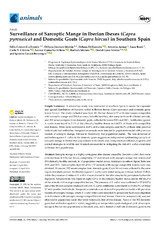Mostrar el registro sencillo del ítem
Surveillance of Sarcoptic Mange in Iberian Ibexes (Capra pyrenaica) and Domestic Goats (Capra hircus) in Southern Spain
| dc.contributor.author | Gómez-Guillamón, Félix | |
| dc.contributor.author | Jiménez-Martín, Débora | |
| dc.contributor.author | Dellamaria, Debora | |
| dc.contributor.author | Arenas, Antonio Pablo | |
| dc.contributor.author | Rossi, Luca | |
| dc.contributor.author | Citterio, Carlo V. | |
| dc.contributor.author | Camacho Sillero, Leonor Natividad | |
| dc.contributor.author | Moroni, Barbara | |
| dc.contributor.author | Cano Terriza, David | |
| dc.contributor.author | García-Bocanegra, Ignacio | |
| dc.date.accessioned | 2024-04-16T12:11:50Z | |
| dc.date.available | 2024-04-16T12:11:50Z | |
| dc.date.issued | 2024 | |
| dc.identifier.uri | http://hdl.handle.net/10396/27925 | |
| dc.description.abstract | Sarcoptic mange is a highly contagious skin disease caused by Sarcoptes scabiei. Sera were collected from 411 Iberian ibexes, comprising 157 individuals with sarcoptic mange skin lesions and 254 clinically healthy animals, in 13 population nuclei across Andalusia (southern Spain) between 2015 and 2021. Skin samples from 88 of the 157 animals with mange-compatible lesions were also obtained. Moreover, 392 serum samples from domestic goats (Capra hircus) were collected in the same region and study period. Antibodies against S. scabiei were tested using an in-house indirect ELISA, while the presence of mites of S. scabiei was evaluated in the skin samples by potassium hydroxide digestion. Seropositivity was found in eight (3.1%) of the clinically healthy ibexes and in 104 (66.2%) of the animals with mange-compatible lesions. The presence of S. scabiei was confirmed in 57 (64.8%) out of the 88 skin samples analysed and anti-S. scabiei antibodies were found in 49 (86.0%) of these 57 mite-positive individuals. Seropositive animals were detected in population nuclei with previous records of sarcoptic mange, where S. scabiei mites were detected by potassium hydroxide digestion in individuals with sarcoptic mange-compatible external lesions. However, seropositivity was not observed in population nuclei that were historically free of this disease. None of the 392 domestic goats had antibodies against S. scabiei, suggesting an independent epidemiological cycle of sarcoptic mange in Iberian ibex populations in the study area, and a limited or null role of domestic goats in the transmission of the parasite to this wild species. Overall, our findings underscore the importance of maintaining and/or implementing integrated surveillance programs and control strategies in wildlife and livestock, to limit the risk of S. scabiei circulation in Iberian ibex populations. | es_ES |
| dc.format.mimetype | application/pdf | es_ES |
| dc.language.iso | eng | es_ES |
| dc.publisher | MDPI | es_ES |
| dc.rights | https://creativecommons.org/licenses/by/4.0/ | es_ES |
| dc.source | Gómez-Guillamón, F.; Jiménez-Martín, D.; Dellamaria, D.; Arenas, A.; Rossi, L.; Citterio, C.V.; Camacho-Sillero, L.; Moroni, B.; Cano-Terriza, D.; García-Bocanegra, I. Surveillance of Sarcoptic Mange in Iberian Ibexes (Capra pyrenaica) and Domestic Goats (Capra hircus) in Southern Spain. Animals 2024, 14, 1194. | es_ES |
| dc.subject | Caprinae | es_ES |
| dc.subject | Domestic goat | es_ES |
| dc.subject | Mite | es_ES |
| dc.subject | Sarcoptes | es_ES |
| dc.subject | Wild goat | es_ES |
| dc.subject | Monitoring | es_ES |
| dc.title | Surveillance of Sarcoptic Mange in Iberian Ibexes (Capra pyrenaica) and Domestic Goats (Capra hircus) in Southern Spain | es_ES |
| dc.type | info:eu-repo/semantics/article | es_ES |
| dc.relation.publisherversion | https://doi.org/10.3390/ani14081194 | es_ES |
| dc.relation.projectID | Gobierno de España.MUNI.FPU22/03649 | es_ES |
| dc.rights.accessRights | info:eu-repo/semantics/openAccess | es_ES |

